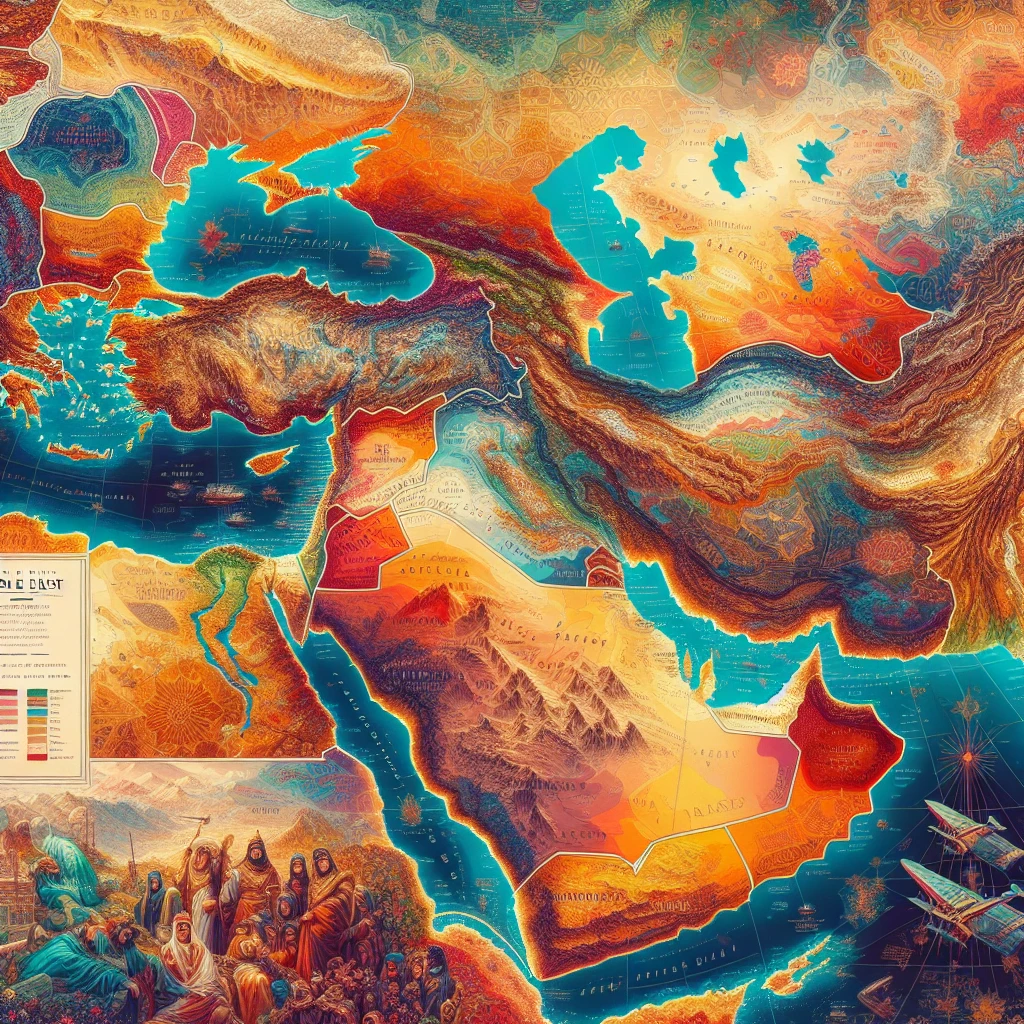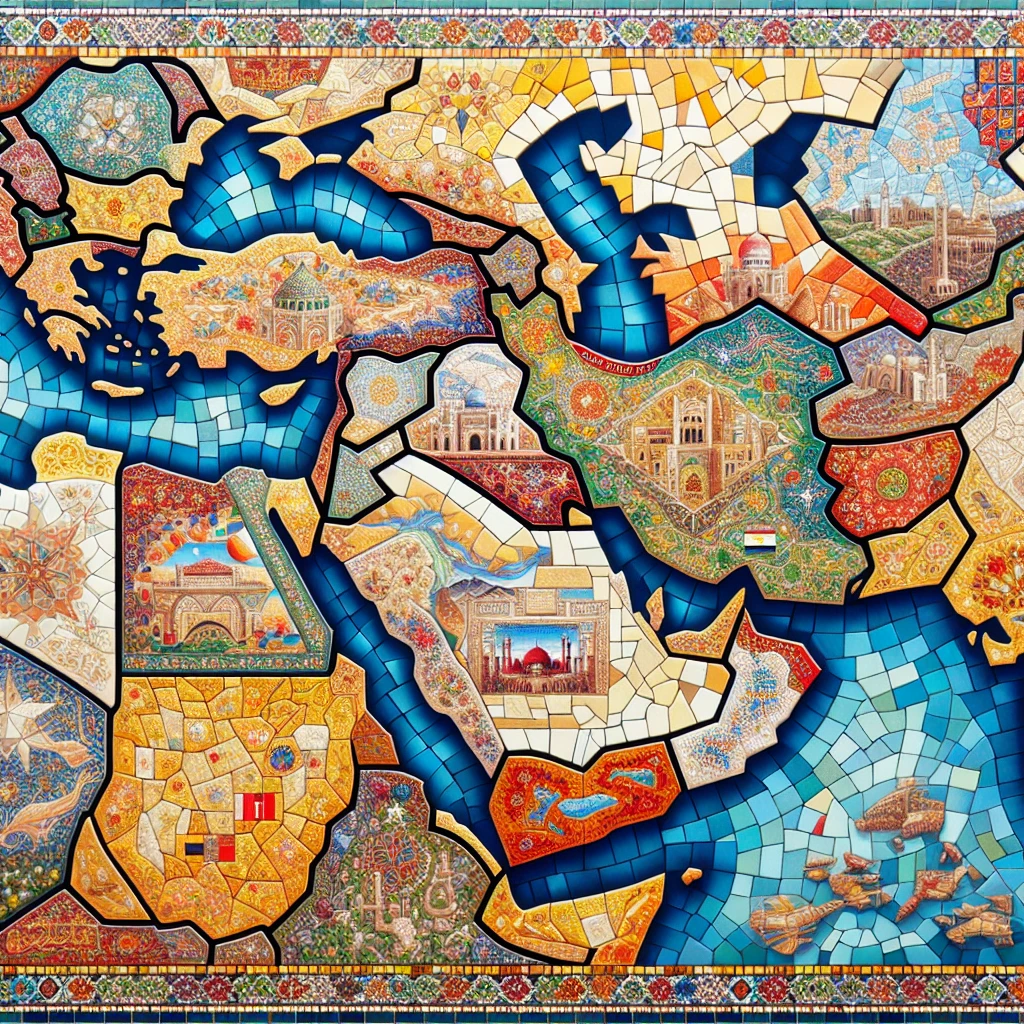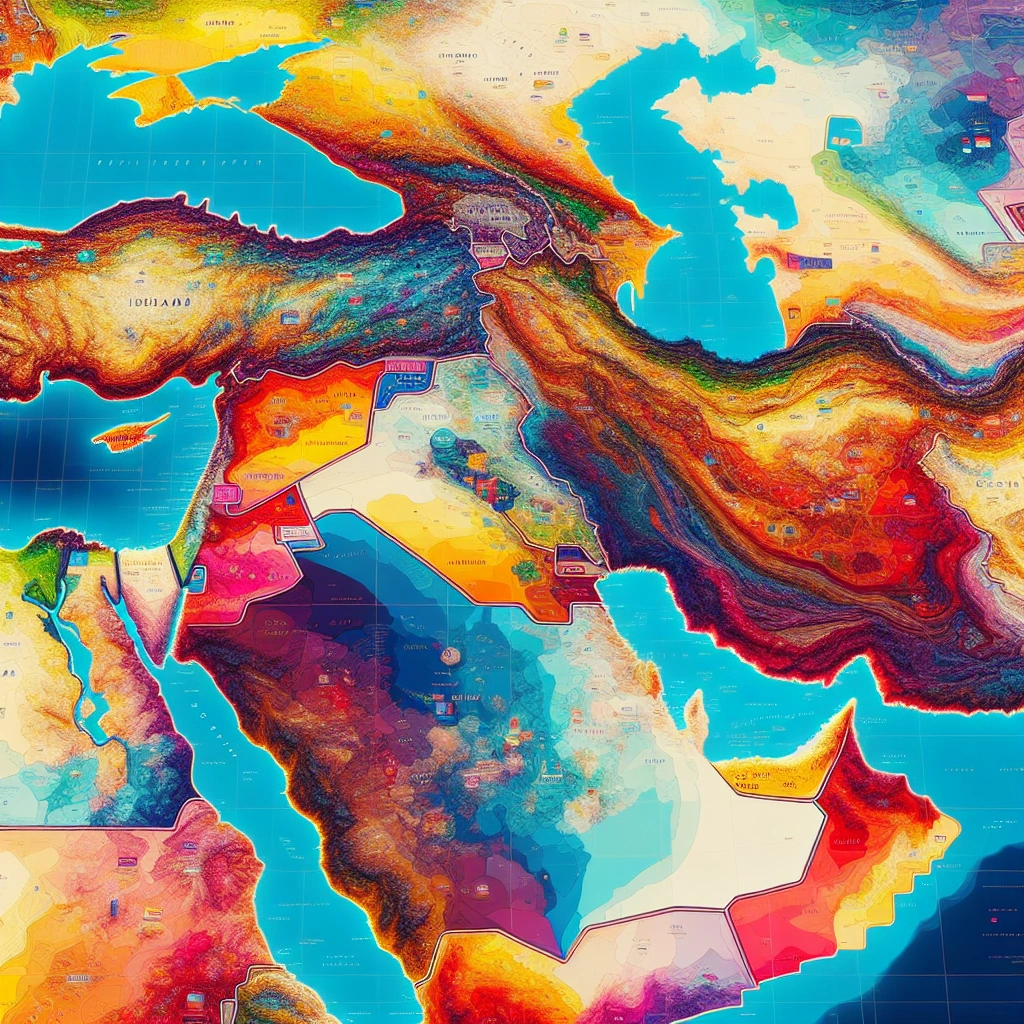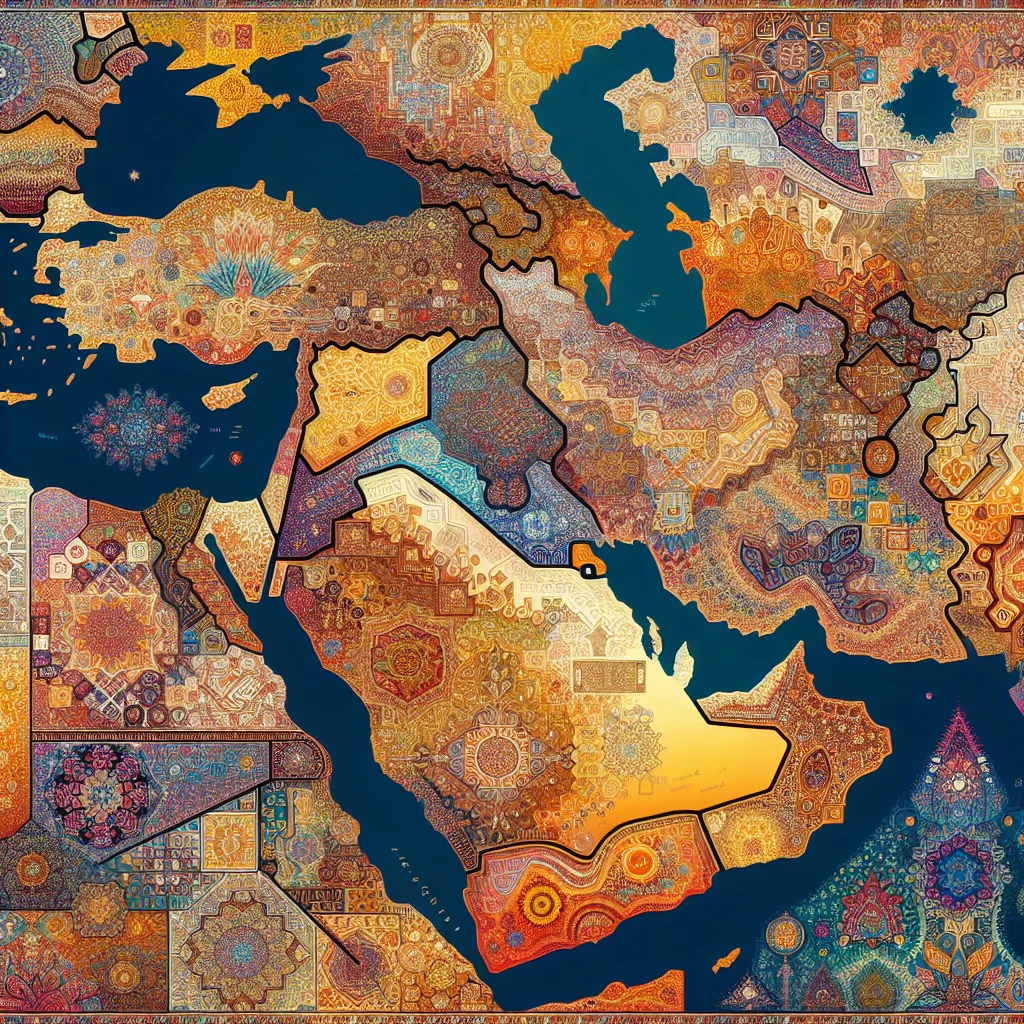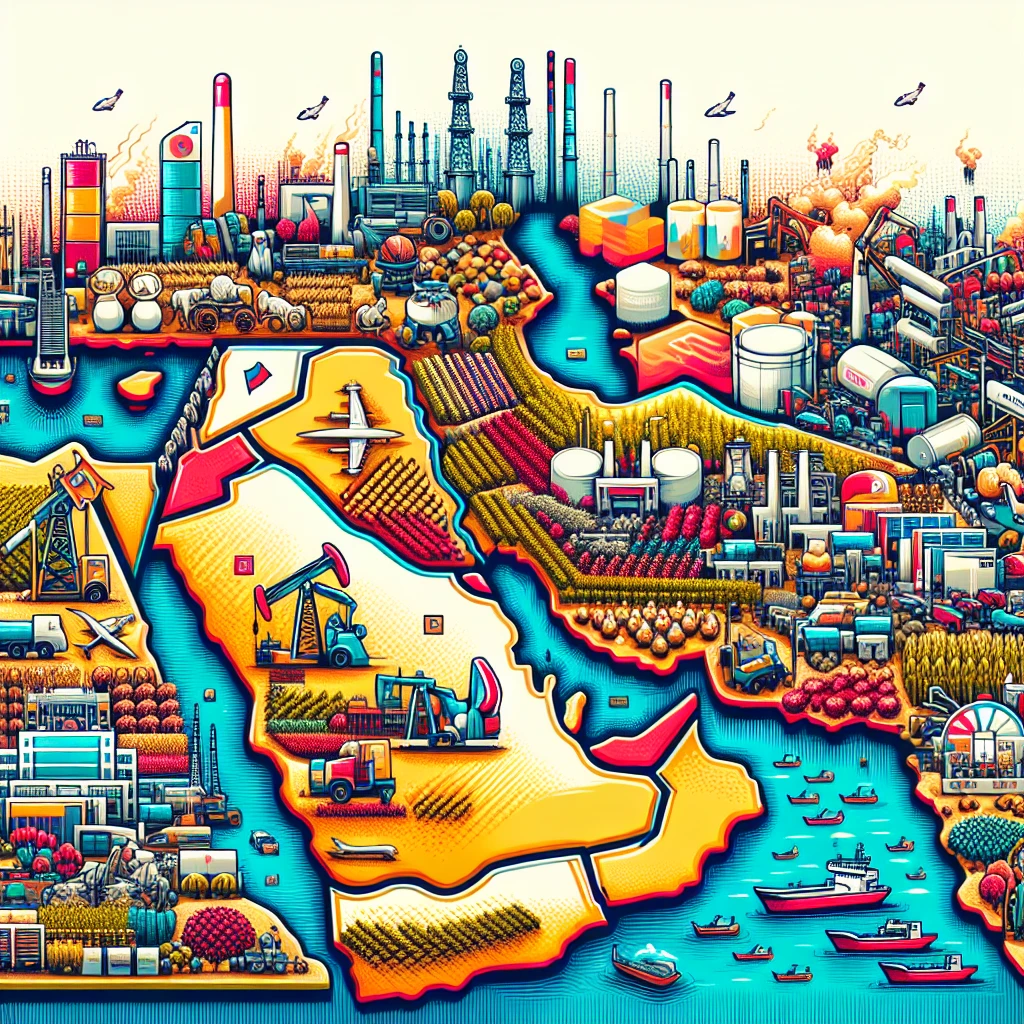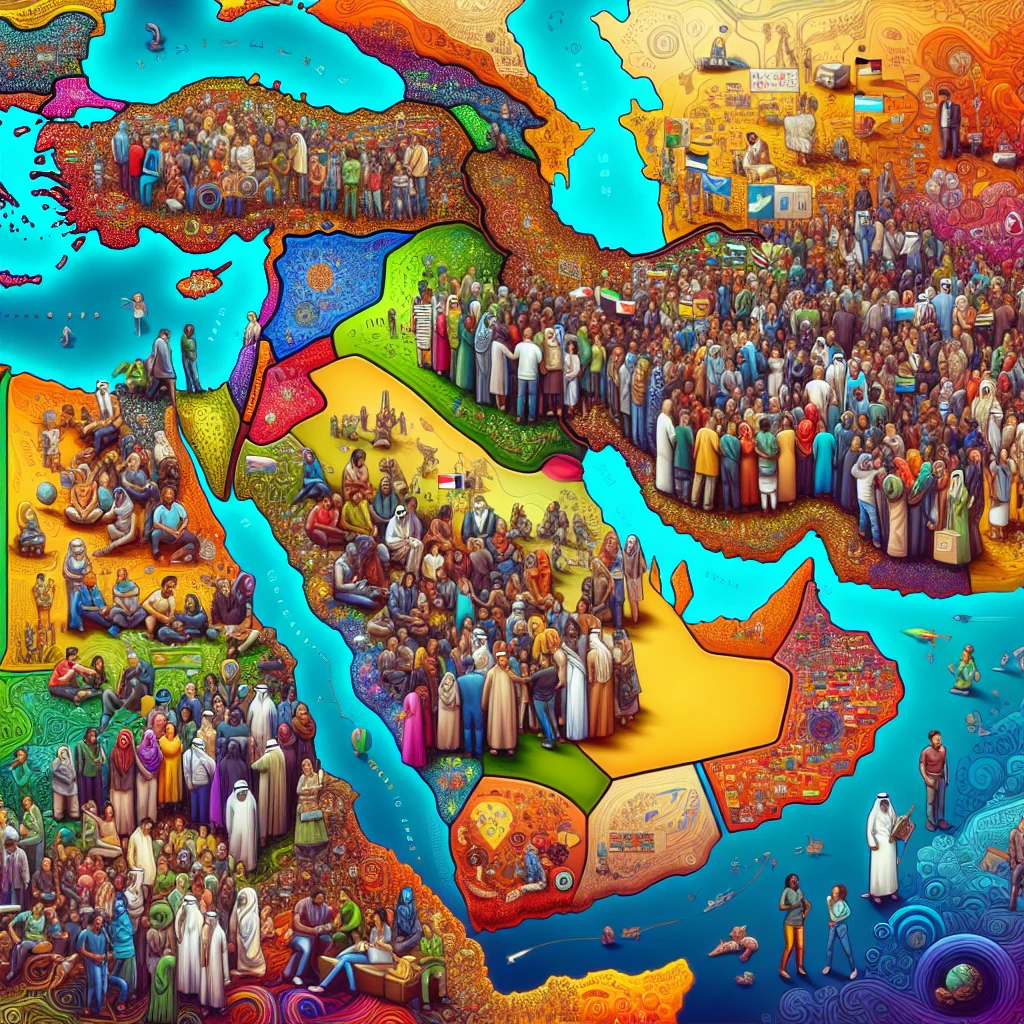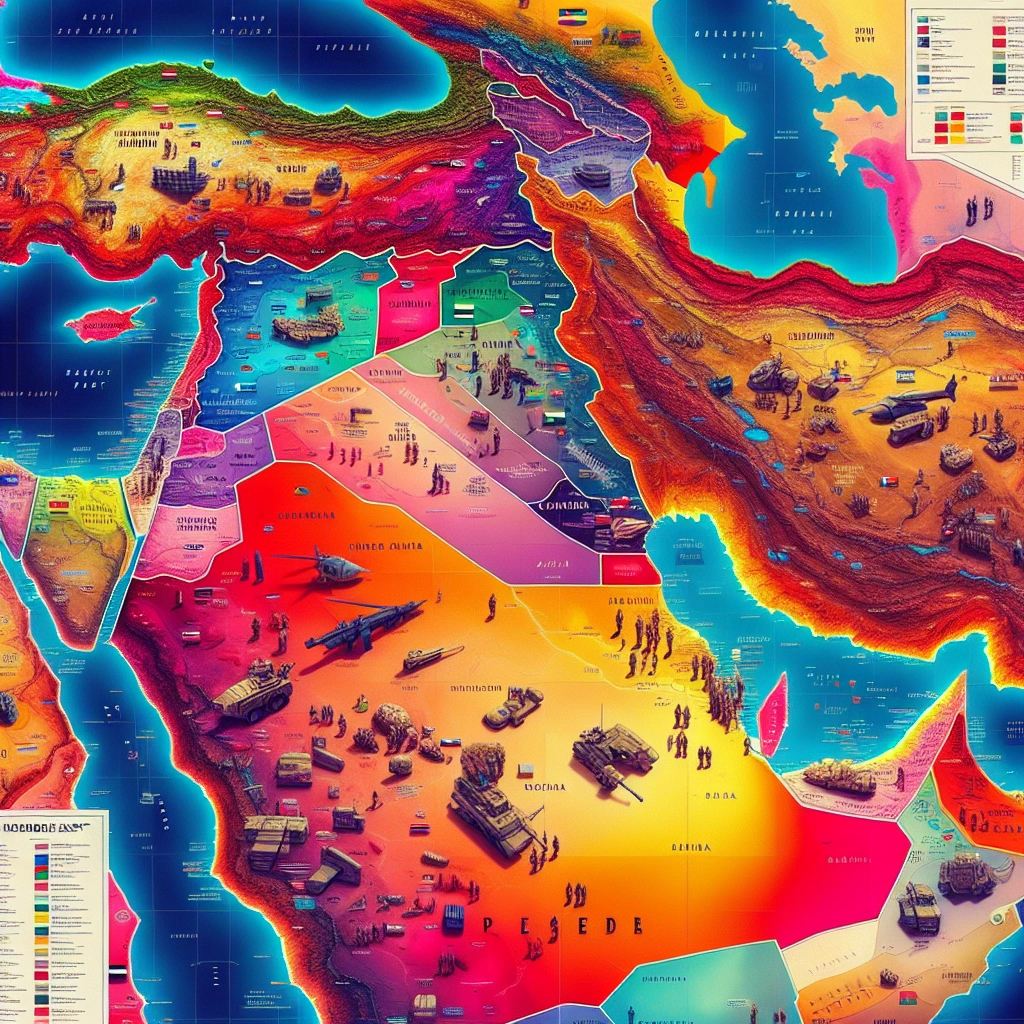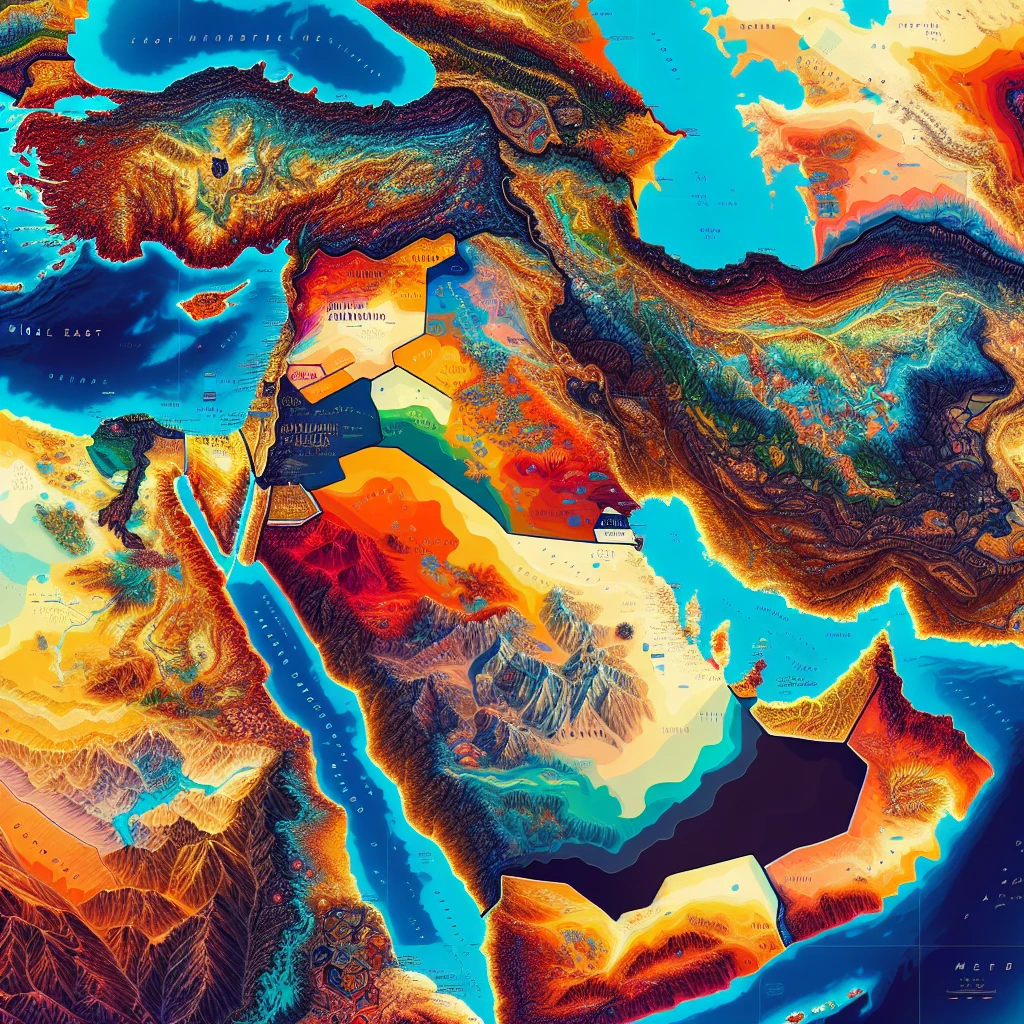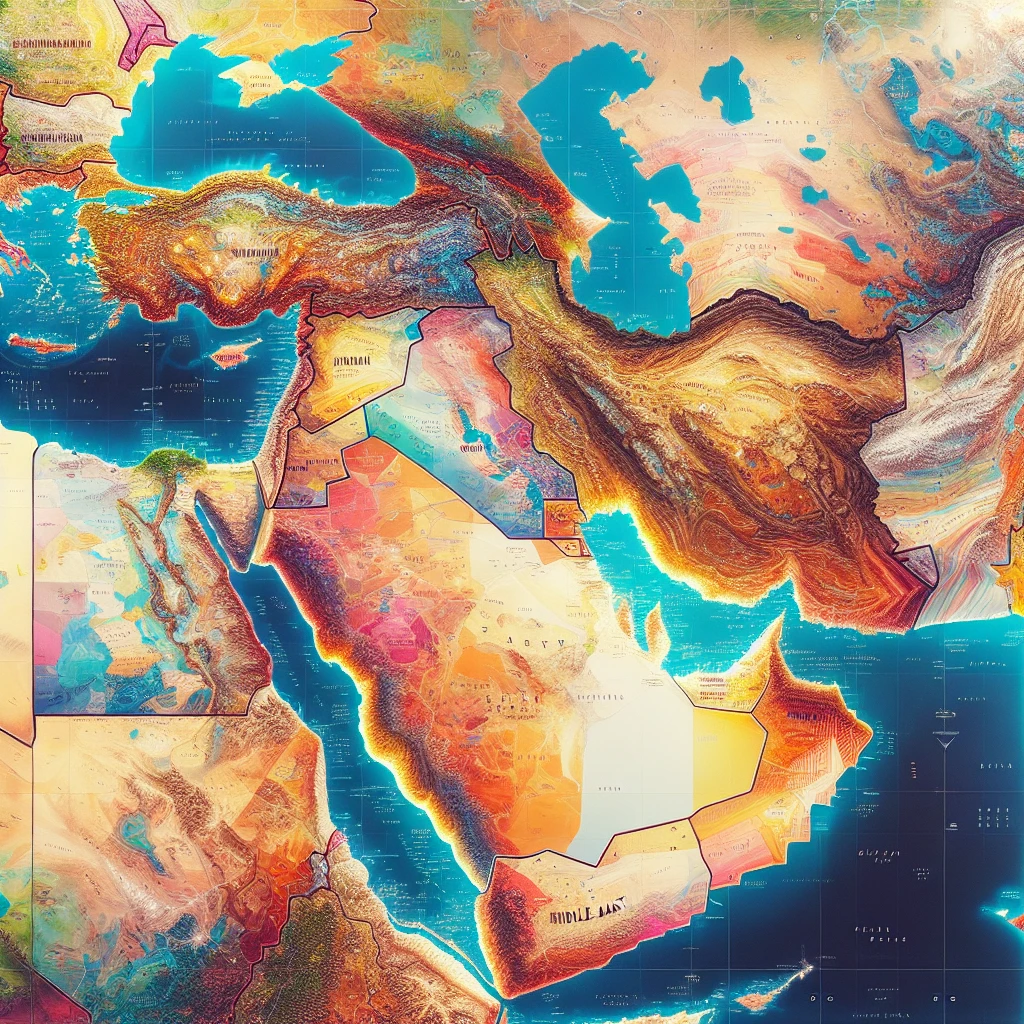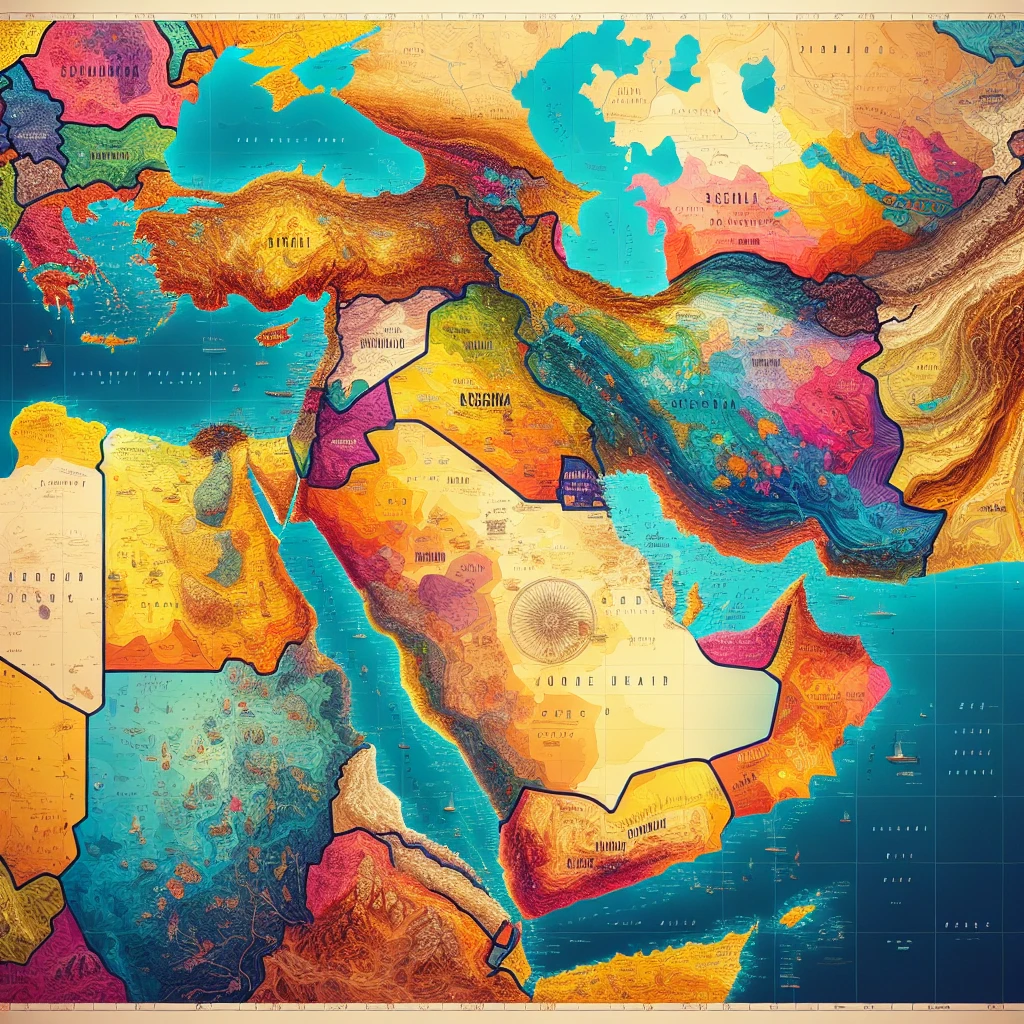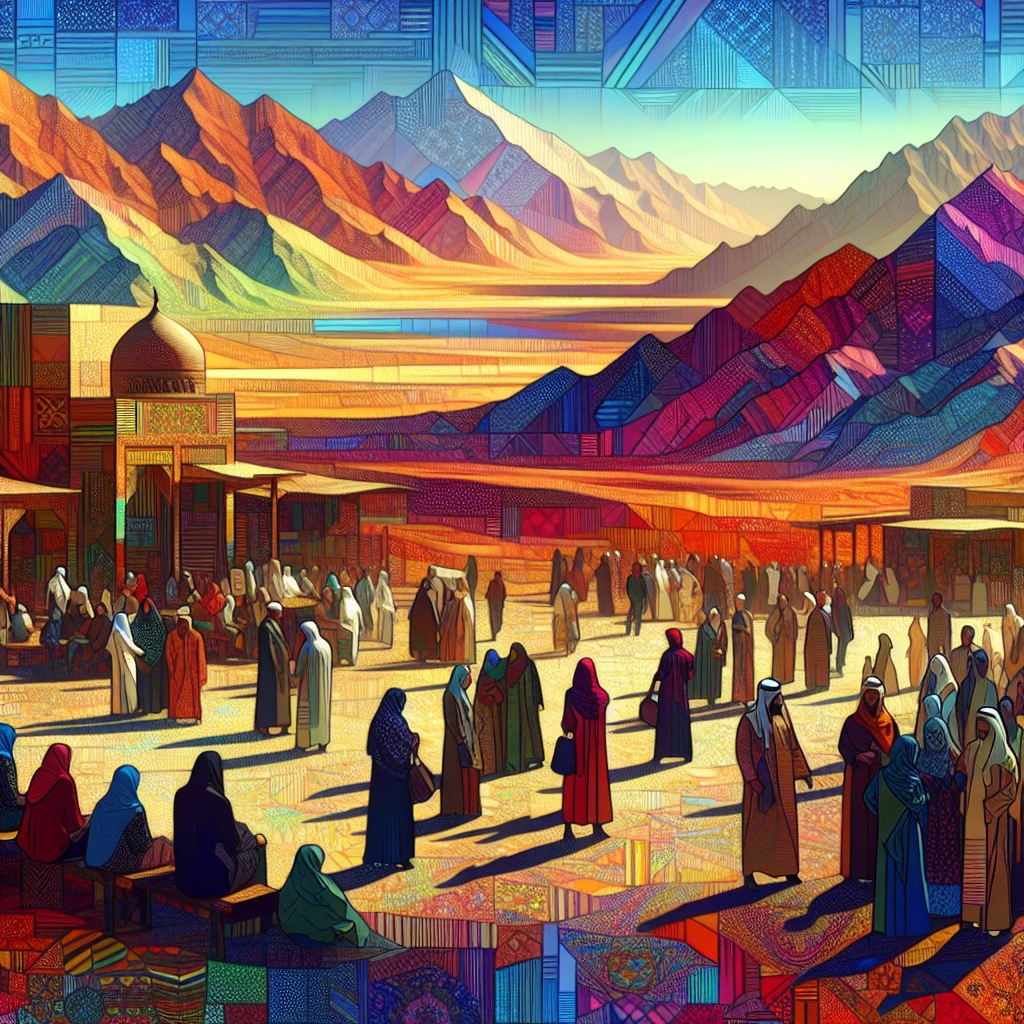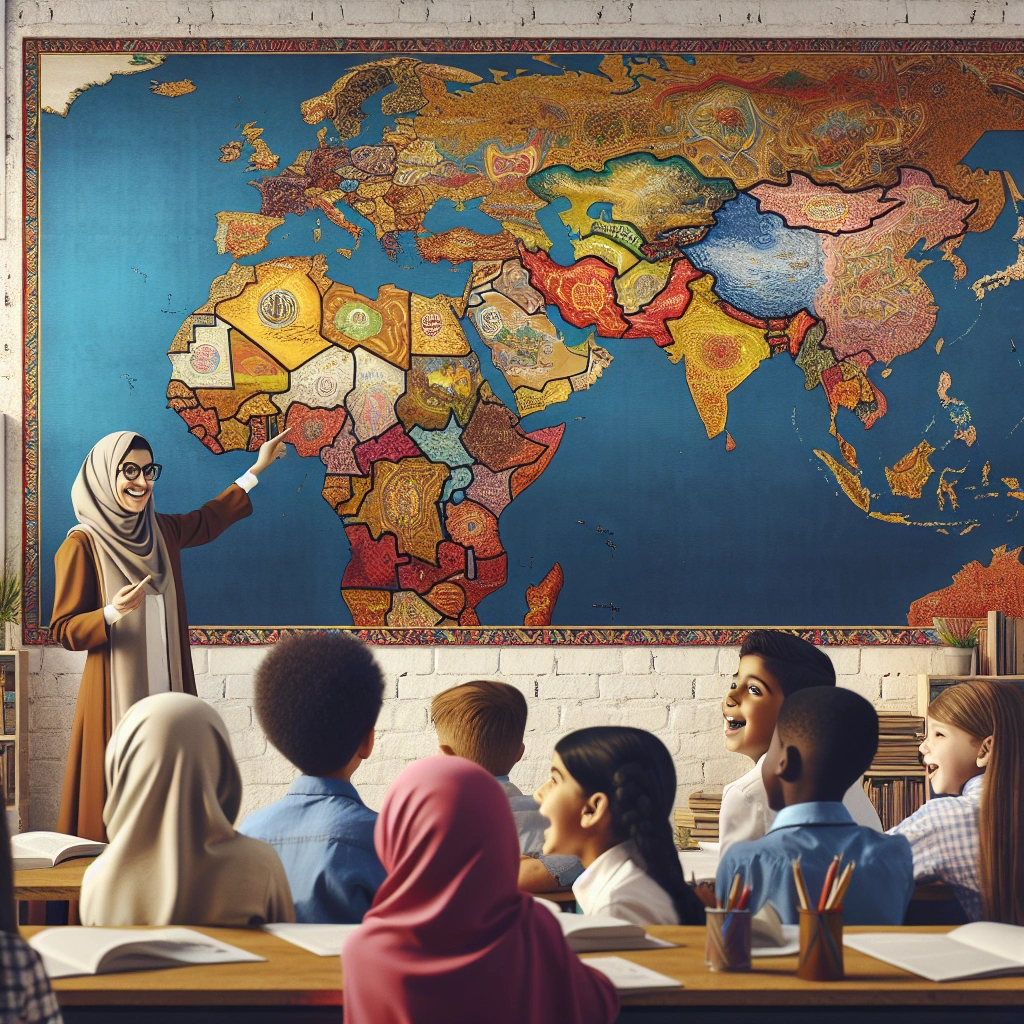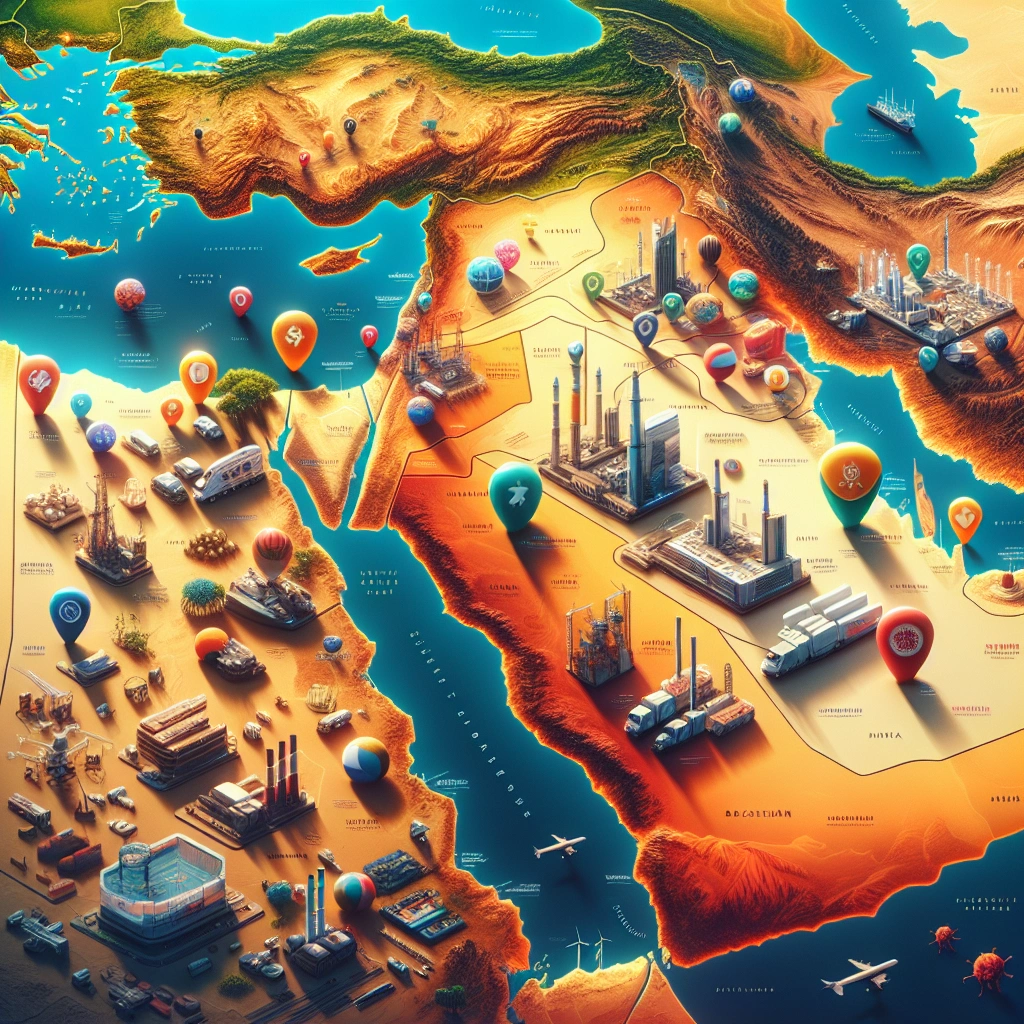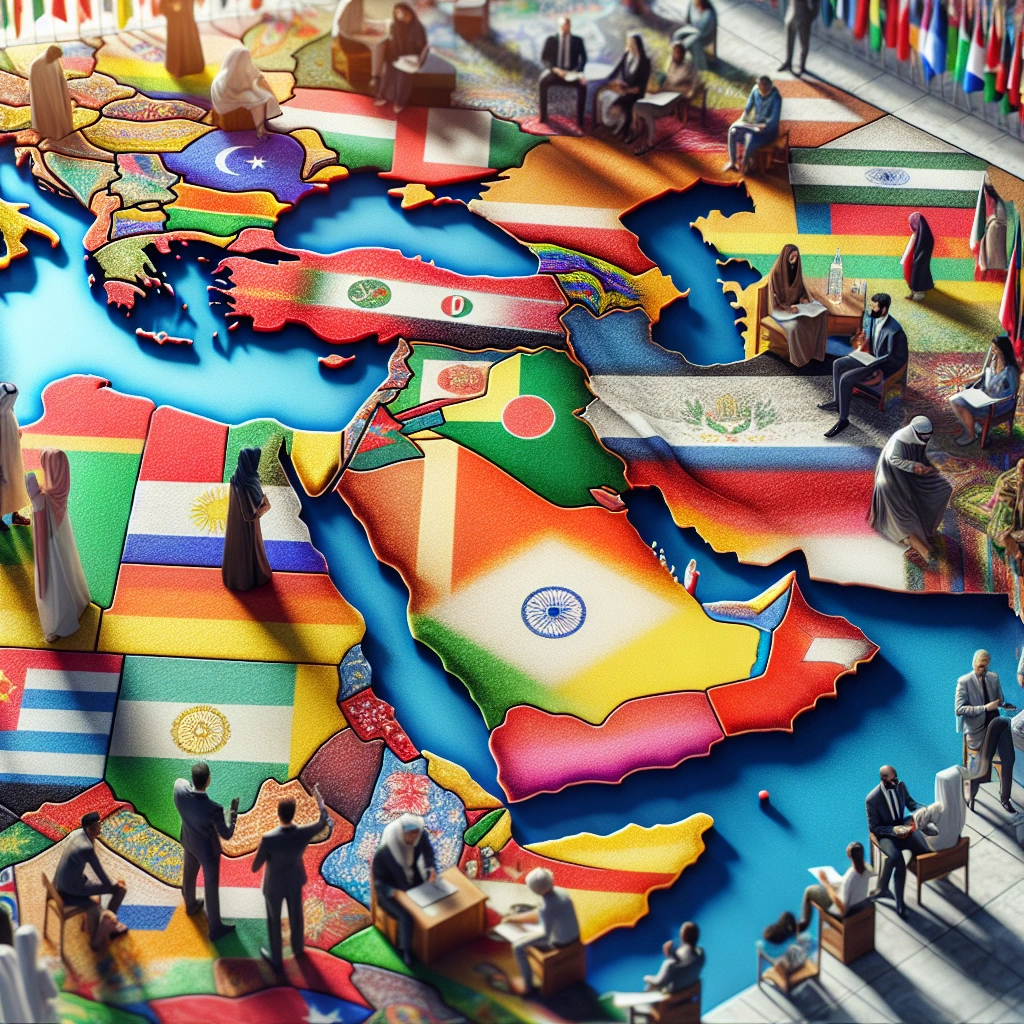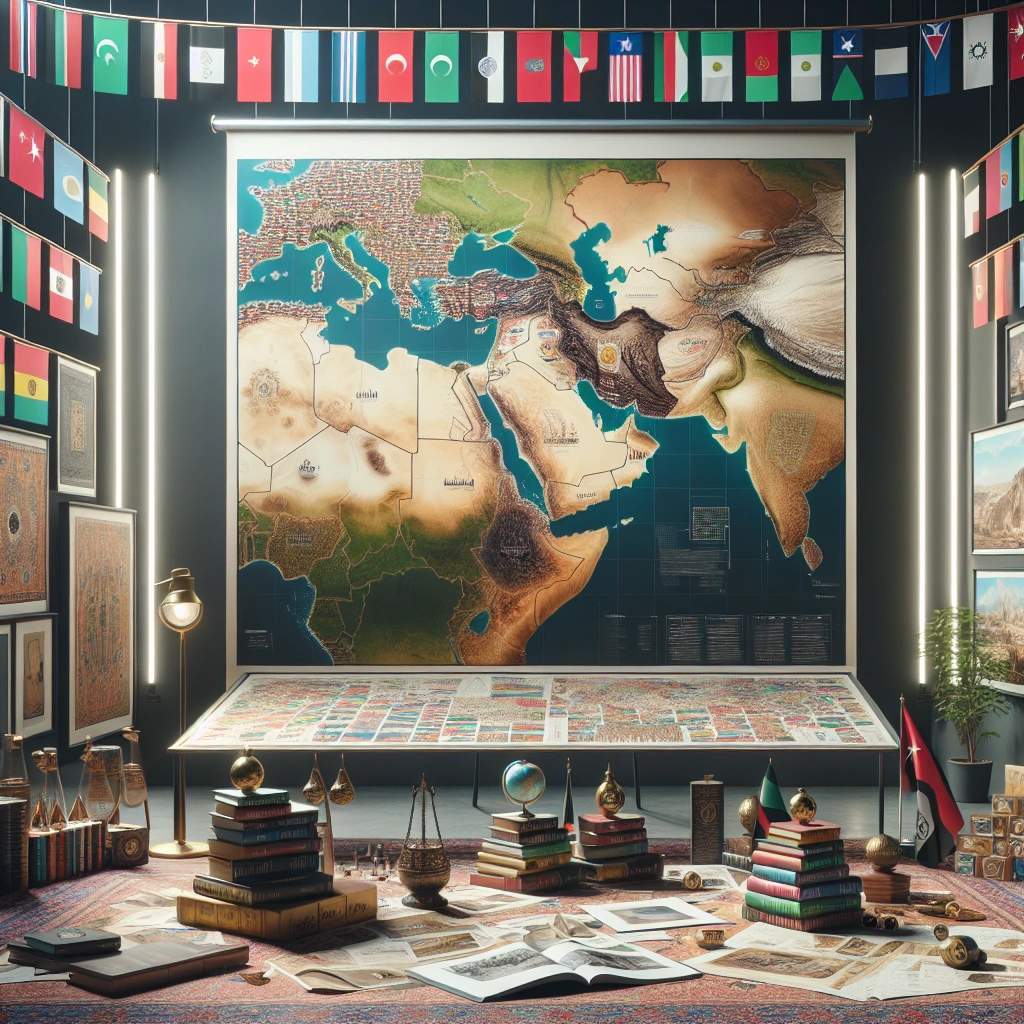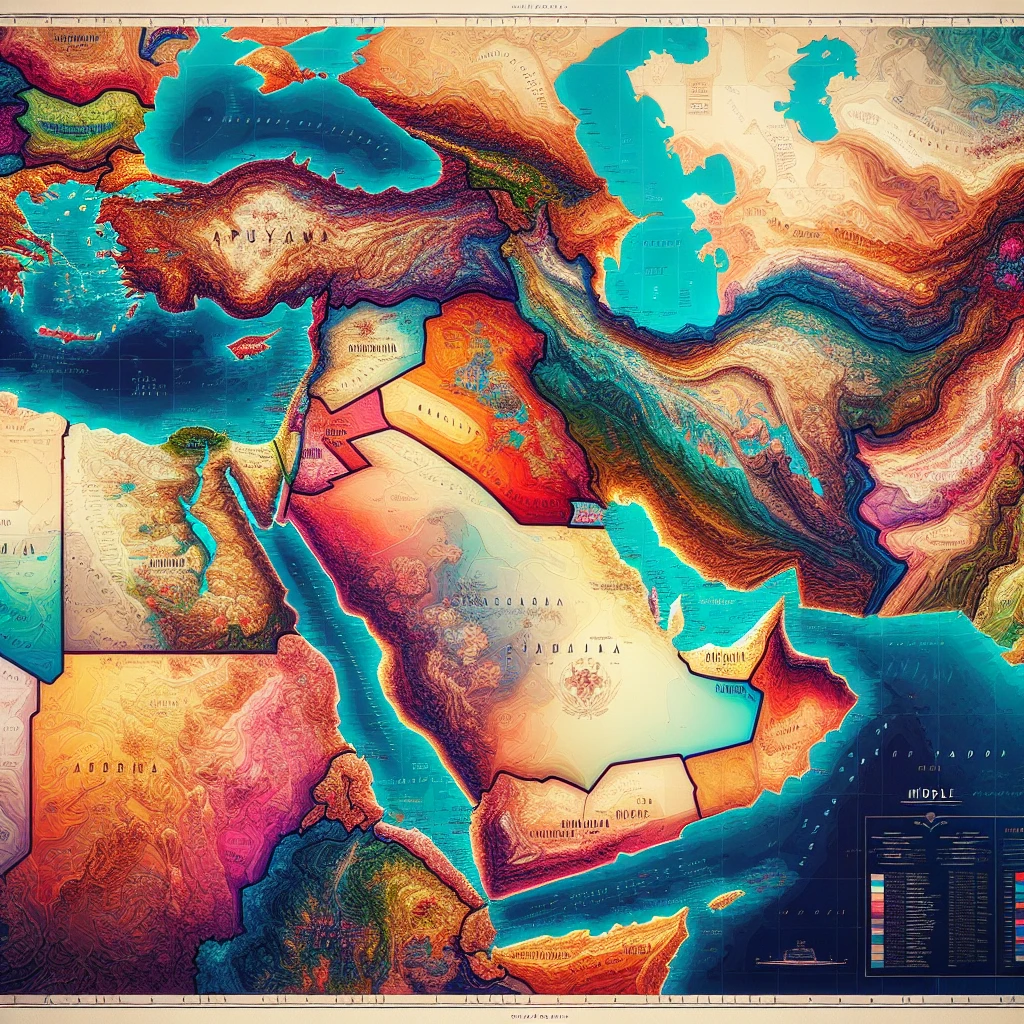

The Middle East is a geographical and cultural region located primarily in western Asia, but also in parts of northern Africa and southeastern Europe. It is situated at the crossroads of Europe, Asia, and Africa and is bordered by multiple oceans and seas.
The Middle East serves as the connective tissue of the continents of Europe, Africa, and Asia, and is located within important trade routes and military chokepoints.
The high antiquity of civilization in the Middle East is largely due to the existence of convenient land bridges and easy sea lanes passable in summer or winter, in dry or wet seasons.
Check out this Youtube video: If you want a comprehensive understanding of the history of the Middle East, this video will take you through the region’s journey year by year.
Geography of the Middle East
Topographical features of the Middle East
Geographically, the Middle East is characterized by an array of topographical features, including mountain ranges such as the Zagros and Elburz Mountains in the west and north, and the Taurus mountains housing Mount Ararat in the north. These rugged mountains and plateaus have a significant impact on the region’s infrastructure and settlement patterns.
Moreover, the Hejaz and Asir Mountains in the southwest of Saudi Arabia further contribute to the diverse topography of the region.
Climate and natural resources
The Middle East experiences a hot and dry climate, predominantly characterized by arid and semi-arid environments. However, the region also boasts abundant natural resources.
Historically, rivers have played a crucial role in allowing productive agriculture, leading to the settling of early civilizations. The region’s rich and fertile soil facilitated the growth of agriculture, enabling the domestication of animals and the thriving of ancient societies.
Impact of geography on the region’s history and development
The geography of the Middle East has had a profound impact on the region’s history and development. Mountains and deserts have acted as natural barriers, effectively dividing the region into distinct zones and influencing the maintenance of cultural differences.
Additionally, the fertile land along the banks of rivers, such as the Tigris and Euphrates, and the Nile, were pivotal in the birth and sustenance of ancient civilizations. These geographical factors have shaped the historical and cultural trajectory of the Middle East.
| Topographical Features | Description |
|---|---|
| Zagros and Elburz Mountains | Found in the west and north of the Middle East, these mountains contribute to the region’s diverse topography. |
| Taurus mountains and Mount Ararat | The Taurus mountains, home to Mount Ararat, influence the northern landscape of the Middle East. |
| Hejaz and Asir Mountains | Located in the southwest of Saudi Arabia, these mountains add to the varied topographical features of the region. |
The topography, climate, and abundant natural resources of the Middle East have profoundly influenced the region’s history, development, and human settlement patterns, making it a unique and diverse geographical area.
Historical Overview
The ancient Middle East was the cradle of civilization, giving rise to empires such as Mesopotamia, Babylonia, the Persian Empire, and the Byzantine Empire. These civilizations laid the foundation for the development of early human societies and greatly influenced the cultural, religious, and political landscape of the region.
The Ottoman Empire, a dominant Islamic superpower, exerted significant influence over the Middle East, North Africa, and Eastern Europe from the 14th to the early 20th century. Its rapid expansion saw it governing vast territories and shaping the geopolitical dynamics of the region.
Following the decline of the Ottoman Empire, European colonial powers engaged in the redrawing of borders in the 20th century, leading to the establishment of artificial nation-states. This arbitrary demarcation disregarded ethnic and religious affiliations, leading to conflicts and tensions among diverse groups in the region.
Countries in the Middle East
Regional overview of countries
- The Middle East comprises countries like Bahrain, Cyprus, Egypt, Iran, Iraq, Israel, Jordan, Kuwait, Lebanon, Oman, Palestine, Qatar, Saudi Arabia, Syria, Turkey, United Arab Emirates, and Yemen. These countries form a diverse region with rich cultural heritage and historical significance.
Political boundaries and territories
- The political boundaries and territories in the Middle East have been shaped by historical events, with some borders being disputed. For example, the Arab-Israeli conflict has led to contentious territorial disputes and the delineation of borders, impacting the geopolitical landscape of the region.
Brief history of each country
- Each country in the Middle East has a unique and intricate history shaped by ancient civilizations, colonialism, and geopolitical conflicts. For instance, Iraq has a rich historical past dating back to Mesopotamia, often referred to as the cradle of civilization, while Israel has a complex history influenced by religious, cultural, and political factors.
| Country | Brief History |
|---|---|
| Egypt | Ancient civilization tracing back to the Pharaohs, rich cultural heritage, and influence on world history. |
| Iran | Formerly known as Persia, with a diverse history encompassing various powerful empires and a significant impact on art, culture, and religion. |
| Israel | Significant religious and historical importance, a land of profound significance for Judaism, Christianity, and Islam. |
| Jordan | A country with historical sites like Petra and a strategic location in the region’s history. |
| Turkey | A blend of Eastern and Western influences with a captivating history from the Byzantine Empire to the Ottoman Empire. |
| Saudi Arabia | Known for its historical role in the rise of Islam and with a rich cultural heritage. |
These countries have contributed significantly to human history and continue to play crucial roles in the contemporary world.
Political Dynamics
Major political alliances and conflicts
- The Middle East region is characterized by major political alliances and conflicts, with prominent alliances such as the Arab League being pivotal in shaping regional dynamics.
- Conflicts such as the ongoing Saudi-Iran rivalry and the Israel-Palestine dispute have significant impacts on the political landscape, contributing to longstanding tensions and power struggles in the region.
- The Gulf Cooperation Council (GCC) serves as a key political alliance, while conflicts like the Yemen Civil War and Syrian Civil War continue to shape the geopolitical dynamics.
Impact on international relations
- The Middle East’s political alliances and conflicts greatly impact international relations, influencing global diplomacy and strategic alliances.
- The region’s alliances and conflicts act as influential factors in shaping intergovernmental relationships, with major powers such as the United States, Russia, and China being deeply involved in Middle Eastern affairs.
- Struggles for dominance and influence, particularly between Saudi Arabia and Iran, reverberate on an international scale, impacting policies and alliances beyond the region’s borders.
Key players in the region
- Key political players in the Middle East include Saudi Arabia, Iran, Israel, Turkey, and Egypt, each wielding substantial influence in regional politics.
- Non-state actors like Hezbollah and Hamas also play vital roles, contributing to the complexity of political dynamics in the Middle East.
- The involvement of external powers like the United States, Russia, and the European Union further complicates the region’s geopolitical landscape, shaping key decisions and policies.
| Country/Player | Role/Influence |
|---|---|
| Saudi Arabia | Significant political and economic influence, particularly within the Gulf region. |
| Iran | Major player in shaping regional power dynamics, often engaged in proxy conflicts and alliances. |
| Israel | Prominent in regional security and geopolitics, impacting the Israel-Palestine conflict and broader regional stability. |
| Turkey | Strategic involvement in the Syrian and Libyan conflicts, contributing to regional power dynamics. |
| Egypt | Crucial in influencing North African and Middle Eastern politics, with historical significance in regional stability. |
The complexities and interactions of these key players, alliances, and conflicts in the Middle East create a volatile and ever-changing geopolitical landscape, with global ramifications for international relations and diplomacy.
Cultural Diversity
Ethnic groups and religious demographics
The Middle East is a diverse region with a rich tapestry of ethnic groups and religious demographics. From the predominantly Arab populations to the presence of Kurds, Turks, Persians, and many other ethnicities, the region boasts a wide array of diverse cultural backgrounds.
When it comes to religious demographics, the Middle East is the birthplace of three major world religions: Islam, Christianity, and Judaism. Each of these religions has significant influence and impact on the cultural fabric of the region.
Cultural influences and traditions
The cultural influences and traditions in the Middle East are deeply rooted in history and have shaped the identity of the region. From vibrant and colorful festivals to traditional cuisines, music, arts, and architecture, the Middle East is a melting pot of cultural diversity.
The influence of religion is prominent in daily life, setting the tone for social interactions, family structures, and community practices.
Challenges and opportunities in a diverse region
The diverse nature of the Middle East presents both challenges and opportunities. While cultural diversity can lead to innovation, creativity, and a broader understanding of the world, it also comes with the challenges of prejudice, discrimination, and cultural conflicts.
Embracing and respecting diversity can pave the way for improved social cohesion, economic growth, and a platform for meaningful cross-cultural dialogue.
| Challenges | Opportunities |
|---|---|
| Prejudice | Innovation |
| Discrimination | Creativity |
| Cultural conflicts | Broad understanding of the world |
The Middle East map is a mosaic of ethnic, religious, and cultural diversity, offering both challenges and opportunities for the region’s inhabitants. Embracing this diversity can lead to a more harmonious and prosperous future for everyone involved.
Economic Landscape
Oil production and its impact on the global economy
Oil production in the Middle East significantly impacts the global economy. The region is a major player in the production and export of oil, influencing global oil prices and supply.
With the Middle East accounting for a substantial portion of the world’s crude oil reserves, fluctuations in production levels have far-reaching effects on the global economy. Additionally, geopolitical tensions in the region can lead to supply disruptions, further affecting oil prices and the overall global economic landscape.
Diversification of economies
The Middle East is actively pursuing economic diversification to reduce its reliance on oil as the primary revenue source. Countries like Saudi Arabia and the United Arab Emirates are investing in non-oil sectors such as tourism, technology, and renewable energy to broaden their economic base.
By diversifying their economies, these nations aim to foster sustainable growth, create employment opportunities, and strengthen their resilience to oil price volatility.
Regional trade and commerce
The Middle East’s strategic geographic location has positioned it as a crucial hub for regional trade and commerce. Nations in the region engage in cross-border trade agreements, leveraging their proximity to major global markets.
Furthermore, the development of infrastructure, such as ports and transportation networks, enhances the efficiency of regional trade, promoting economic integration and fostering partnerships with neighboring countries.
| Economies | Key Highlights |
|---|---|
| Oil Production | – Major influence on global oil prices and supply – Geopolitical tensions impact global oil market |
| Diversification | – Shift towards non-oil sectors – Emphasis on tourism, technology, and renewable energy |
| Regional Trade | – Strategic location for regional trade – Infrastructure development for efficient commerce |
This table showcases the key highlights of the Middle East’s economic landscape, emphasizing the impact of oil production, efforts towards economic diversification, and the region’s role in facilitating regional trade and commerce.
Social Issues
Human rights and social justice
The situation of human rights and social justice in the Middle East continues to be a matter of great concern. From the effective siege of the Tigray region, denying civilian access to necessities, to the double standards on human rights and the failure of the international community to unite around universal values, the region faces significant challenges.
The ongoing violations highlight the urgent need for global attention and action to address these pressing issues.
Women’s rights and gender equality
In the Middle East, women and girls still face discrimination on the basis of their sex and gender, despite the fundamental human rights and United Nations values advocating for equality. Millions of women and girls experience discrimination, violence, and denial of their autonomy.
This deep-rooted discrimination and violence against women persistently plague the fabric of societies, highlighting the ongoing struggle for gender equality in the region.
Refugee crisis and humanitarian challenges
The Middle East’s refugee crisis and humanitarian challenges necessitate urgent, life-saving support ranging from food, shelter, safe drinking water, and emergency healthcare. The region’s growing humanitarian needs, particularly amid conflicts, pose a significant test for the future of international law and state responsibility.
Addressing these challenges requires collaboration among humanitarian agencies, the private sector, governments, and other stakeholders to identify areas for action and provide necessary assistance.
Conflict and Security
Ongoing conflicts and their root causes
The ongoing conflicts in the Middle East are deeply rooted in historical, religious, and ideological differences. Issues such as territorial disputes, sectarian divisions, and power struggles have fueled these conflicts for generations, leading to heightened tensions and violent confrontations.
Role of external powers in regional stability
External powers have played a significant role in influencing regional stability in the Middle East. Superpowers and neighboring countries have often intervened in the region, either directly or indirectly, exacerbating existing conflicts and rivalries.
Their strategic interests and geopolitical agendas have contributed to the perpetuation of instability in the region.
Efforts towards peace and resolution
Efforts towards peace and resolution in the Middle East have been on the global agenda for decades. Diplomatic initiatives, peace negotiations, and international interventions have aimed to mitigate the tensions and reach a lasting resolution.
However, the complexity of the conflicts and the involvement of multiple stakeholders have presented significant challenges in achieving sustainable peace and stability.
Middle East Map: Modern Challenges
Environmental concerns
The Middle East faces dire environmental challenges, from water scarcity and food insecurity to the looming specter of climate change. The region is projected to be among the first in the world to bear the brunt of escalating climate effects, including draining precipitation, prolonged droughts, and escalating sea levels.
The World Bank estimates that by 2050, climate-related water scarcity could cost Middle Eastern nations between 6 to 14 percent of their GDP. This calls for urgent and strategic interventions to address the environmental crises plaguing the region.
Infrastructure development
The Middle East is undergoing a significant transformation with game-changing projects like The Red Sea Project, Neom, the Maritime City, and the Qiddiya Entertainment City, making Saudi Arabia a proactive construction market. These ambitious infrastructural developments are set to create improved tourist attractions, entertainment venues, financial and health centers, and residential facilities.
The value and scale of work involved reflect a considerable shift in the region’s construction landscape, positioning it at the forefront of innovation and progress.
Urbanization and population growth
With a rapid shift towards urbanization, the Middle East has experienced extraordinary population growth, surpassing all regions of the world except sub-Saharan Africa. The region’s average annual urban growth rate of 4% in the past two decades underscores the significant urban expansion.
However, managing such burgeoning urban populations poses challenges, from housing shortages to sustainable development concerns. The demographic transition and influx of internal and cross-border individuals have contributed to this demographic surge, necessitating strategic planning to accommodate and sustain this remarkable growth.
Middle East Map: Future Prospects
Prospects for peace and stability
The Middle East region has historically been marred by conflicts and tensions, but there are glimpses of hope for peace and stability. The recent Abraham Accords between several Arab nations and Israel signify a positive shift in diplomatic relations, fostering the potential for long-term stability in the region.
Additionally, the ceasefire agreements in certain conflict zones offer a glimmer of hope for sustained peace and stability.
Economic development and innovation
The Middle East is gradually transforming into a hub for economic development and innovation. Nations such as the United Arab Emirates and Saudi Arabia are investing heavily in technological advancements, renewable energy, and sustainable infrastructure.
With a focus on diversifying their economies beyond oil, these countries are fostering entrepreneurship, attracting global investments, and creating a conducive environment for innovation and growth.
Changing geopolitical dynamics
The geopolitical dynamics in the Middle East are evolving rapidly, shaping the global landscape. The emergence of new alliances and strategic partnerships, along with shifting power dynamics, has brought about unprecedented changes.
Various initiatives, such as the Belt and Road Initiative, are redefining the region’s geopolitical influence, presenting new opportunities and challenges for both regional and global stakeholders.
Understanding the Middle East Map
Importance of accurate mapping
Accurate mapping in the Middle East is crucial for geopolitical understanding and strategic decision-making. For example, precise mapping helps in demarcating borders, examining resource distribution, and analyzing environmental factors.
This ensures clarity on regional dynamics and political complexities and aids in conflict resolution and diplomatic negotiations. Inaccurate mapping can lead to misunderstandings, disputes, and even conflicts.
Impact of technology on mapping
Technological advancements have revolutionized mapping in the Middle East, enabling high-resolution satellite imagery, GPS tracking, and digital mapping tools. This has enhanced the accuracy, detail, and accessibility of mapping data, facilitating comprehensive analysis and decision-making.
For instance, remote sensing technology has enabled the monitoring of environmental changes and natural resource management, while GIS technology has facilitated spatial data analysis, supporting urban planning and infrastructure development.
Role of cartography in understanding regional dynamics
Cartography plays a pivotal role in understanding the complex regional dynamics of the Middle East by visually representing spatial phenomena, such as political boundaries, topography, and demographic distributions. This aids in analyzing historical developments, cultural interactions, and geopolitical influences.
Cartographic representations provide valuable insights into the region’s past and present, shedding light on territorial disputes, cultural diversity, and economic disparities, thus contributing to informed academic and policy discourse.
| Importance of Accurate Mapping | Impact of Technology on Mapping |
|---|---|
| – Geopolitical understanding | – High-resolution satellite imagery |
| – Border demarcation | – GPS tracking technology |
| – Resource distribution | – Digital mapping tools |
| – Conflict resolution | – GIS spatial data analysis |
| – Diplomatic negotiations | – Remote sensing technology |
| – Environmental monitoring |
This table highlights the importance of accurate mapping in geopolitical understanding and the impact of technology on mapping in the Middle East.
Remember, in the Middle East, accurate mapping is not just lines on paper; it’s a powerful tool for understanding geopolitical dynamics, influenced by advancing technology and the art of cartography.
Exploring the Diversity
Tourist attractions and landmarks
The Middle East boasts a blend of ancient wonders and modern marvels, making it a dream destination for travelers. From the iconic Great Pyramid of Giza in Egypt to the architectural splendor of the Burj Khalifa in Dubai, the region showcases a diverse array of tourist attractions and landmarks.
Each country in the Middle East offers its own unique experiences, such as exploring the ancient city of Petra in Jordan or wandering through the vibrant bazaars of Istanbul, Turkey.
Cultural experiences in different countries
The Middle East is a melting pot of cultures, offering travelers a rich tapestry of experiences. From savoring traditional Middle Eastern cuisine like kebabs, falafel, and baklava to immersing oneself in the art and architecture of ancient civilizations, there is no shortage of cultural experiences to indulge in.
Each country in the region offers its own distinct traditions, festivities, and rituals, providing visitors with a remarkable glimpse into the tapestry of Middle Eastern cultures.
Cross-border collaborations and initiatives
Cross-border collaborations and initiatives in the Middle East are contributing to the development of sustainable tourism and fostering cultural exchange. Countries in the region are coming together to promote joint tourism marketing efforts, opening up new avenues for travelers to explore the diverse heritage and attractions across borders.
These initiatives are not only enhancing the tourism industry but also promoting cross-cultural solidarity, paving the way for a more interconnected and harmonious Middle East.
| Country | Iconic Landmark |
|---|---|
| Egypt | Great Pyramid of Giza |
| United Arab Emirates | Burj Khalifa |
| Jordan | Petra |
| Turkey | Bazaars of Istanbul |
Let’s make exploring the Middle East map an unforgettable journey, filled with breathtaking sights, enriching cultural encounters, and collaborative initiatives that bring people together in unity!
Middle East Map in Education
Role in academic curriculum
The Middle East map plays a crucial role in the academic curriculum by providing students with a visual representation of the region’s geography, political boundaries, and cultural diversity. It helps students develop a better understanding of the complex geopolitical landscape, historical significance, and the socioeconomic factors that shape the region.
Educational resources and tools
Educational resources and tools such as interactive Middle East maps, geographical documentaries, and online learning platforms enable students to explore the diverse aspects of the Middle East. These resources offer engaging and immersive experiences, allowing students to delve into the region’s rich history, cultural heritage, and contemporary issues.
Initiatives for promoting geographical awareness
Initiatives for promoting geographical awareness among students include organizing map-based competitions, cultural exchange programs, and interdisciplinary projects that incorporate Middle East geography. These initiatives aim to foster a deeper appreciation for the geographical significance of the Middle East and its global interconnectedness.
| Role in academic curriculum | Educational resources and tools | Initiatives for promoting geographical awareness |
|---|---|---|
| Provides visual representation of the region’s geography, political boundaries, and cultural diversity. | Interactive maps, geographical documentaries, and online learning platforms. | Map-based competitions, cultural exchange programs, and interdisciplinary projects. |
Highlighting Innovations
Technological advancements in mapping
The technological advancements in mapping have been revolutionary, especially in the Middle East. With the use of AI algorithms, digital map building has become faster and more precise.
Emerging GIS technologies, such as Ubiquitous Connectivity, Digital Twins, and Machine Learning, have opened up new possibilities for urban planning, retail, and space exploration. Additionally, the latest mapping technology like UniMap by HERE utilizes AI models for faster data processing and map creation, enhancing the overall mapping experience.
Data visualization and interpretation
Data visualization has seen significant progress, allowing for a deeper understanding of geographical data in the Middle East. This emerging field, considered a sub-classification of visualization, aims to produce images of data that support visual analysis, exploration, and the discovery of novel insights.
Practitioners, including cartographers and statisticians, have been instrumental in utilizing data visualization to gain valuable insights into complex geographical data.
Innovative applications for mapping in the Middle East
In the Middle East, mapping applications have witnessed innovative uses, particularly in the realms of artificial intelligence (AI) and e-commerce. AI is expected to be a disruptive force in the region, generating economic gains of up to $320 billion by 2030 through its adoption.
Furthermore, maps and digital geography applications are being leveraged as excellent tools for educational purposes, providing students with meaningful adventures through geography, cultures, history, and current events.
| Advancements | Description |
|---|---|
| AI algorithms | Enhance speed and precision of digital map building |
| Emerging GIS technologies | Ubiquitous Connectivity, Digital Twins, Machine Learning |
| Data Visualization | Produces images of data supporting exploration and insights |
| AI in the Middle East | Expected to generate significant economic gains by 2030 |
| Digital Geography Applications | Effective tool for educational purposes |
This table summarizes the key technological advancements, data visualization progress, and innovative applications for mapping in the Middle East, showcasing the remarkable developments in the field.
Remember to always embrace the innovations and advancements that reshape the landscape of mapping in the Middle East!
Middle East Map and Global Relations
Influence on international policies
The Middle East has a significant influence on international policies due to its strategic importance in global affairs. Its vast oil reserves, geopolitical relevance, and historical significance have made it a focal point for major powers and international organizations.
The region’s complex dynamics, including ongoing conflicts and security challenges, have shaped the foreign policies of many countries, impacting trade agreements, military alliances, and diplomatic initiatives.
Economic partnerships and collaborations
Economically, the Middle East map plays a crucial role in global partnerships and collaborations. The abundance of natural resources, particularly oil, has led to extensive economic engagements with various countries worldwide.
Energy trade, infrastructure development, and investment opportunities have fostered economic ties between the Middle East and other regions, influencing market dynamics and contributing to global economic growth.
Diplomatic challenges and opportunities
The Middle East presents both diplomatic challenges and opportunities for international actors. Addressing regional conflicts, promoting stability, and fostering mutual understanding amidst diverse cultures are key challenges.
However, these challenges also create opportunities for diplomatic initiatives aimed at conflict resolution, peace-building, and advancing shared interests. Effective diplomacy in the Middle East has the potential to shape international relations and contribute to global peace and prosperity.
| Country | Economic Partnership | Diplomatic Engagement |
|---|---|---|
| United States | Strategic energy partnerships | Peace-seeking diplomacy initiatives |
| China | Infrastructure investments | Mediator role in regional conflicts |
| European Union | Economic cooperation and trade agreements | Humanitarian aid and diplomacy |
Recommended Amazon Products for Understanding the Middle East Map
Here’s a curated list of products that can help you understand the Middle East Map with ease. These recommendations are based on quality, usefulness, and customer reviews.
National Geographic: Middle East Classic Wall Map (30.25 x 24.25 inches)
National Geographic’s Middle East Classic Wall Map provides a detailed and accurate representation of the region’s physical geography, political boundaries, and key infrastructure. This map is highly recommended for educational purposes and comprehensive understanding of the Middle East. Available on Amazon: National Geographic: Middle East Classic Wall Map.


| Pros | Cons |
|---|---|
| Highly detailed and accurate | Relatively large size may not be suitable for small spaces |
| Educational and informative | Rolled format may require additional framing |
Middle East Wall Map Poster by Swiftmaps (24×36 Paper Folded)
Swiftmaps’ Middle East Wall Map Poster is a convenient and affordable option for those seeking an overview of the region’s geography and political boundaries. With clear labeling and vibrant colors, this map is suitable for both educational and decorative purposes. Available on Amazon: Middle East Wall Map Poster by Swiftmaps.


| Pros | Cons |
|---|---|
| Affordable and accessible | Folded format may result in creases |
| Vibrant and clear design | Less detailed compared to other options |
Beirut to Jerusalem by Thomas L. Friedman
“Beirut to Jerusalem” by Thomas L. Friedman is a compelling book that delves into the history, politics, and culture of the Middle East. Through insightful storytelling and analysis, the author provides a comprehensive understanding of the region’s complexities. Available on Amazon: Beirut to Jerusalem by Thomas L. Friedman.


| Pros | Cons |
|---|---|
| In-depth exploration of the Middle East | Does not provide visual geography |
| Engaging and informative narrative | Limited to the reader’s interpretation |
Middle East Map Puzzle by Puzzlelife
The Middle East Map Puzzle from Puzzlelife offers an interactive and engaging way to learn about the geography of the region. This puzzle can be a valuable educational tool for all ages, promoting spatial awareness and understanding of the Middle East. Available on Amazon: Middle East Map Puzzle by Puzzlelife.


| Pros | Cons |
|---|---|
| Interactive and educational | May not suitable for those seeking a traditional map |
| Promotes spatial awareness | Requires assembly |
Kids’ Travel Guide – Middle East: The Fun Way to Discover the World (Kids’ Travel Guide series)
The “Kids’ Travel Guide – Middle East” is an excellent resource for young learners and families interested in exploring the geography and culture of the region. Through interactive activities and lively illustrations, this guide offers an engaging learning experience. Available on Amazon: Kids’ Travel Guide – Middle East.


| Pros | Cons |
|---|---|
| Interactive and engaging for kids | Specifically designed for young learners |
| Promotes cultural awareness | Not suitable for in-depth geography study |
Top Recommended Product for Understanding the Middle East Map
If you’re looking for the best solution to understand the Middle East Map comprehensively, we highly recommend National Geographic: Middle East Classic Wall Map. Here’s why:
National Geographic’s Middle East Classic Wall Map offers a highly detailed and accurate representation of the region’s geography, making it an invaluable educational and reference tool.
Ready to enhance your understanding of the Middle East? Check out National Geographic: Middle East Classic Wall Map today for the best results!


Conclusion
Studying the Middle East map provides valuable insight into the geographic features of the region, such as its deserts, mountains, and rivers. By examining the map, one can also gain an understanding of the various countries and their borders, as well as the strategic importance of the region in global politics and commerce.
Additionally, the Middle East map reveals the diverse cultural and religious identities of the people living in the region, including the distribution of different ethnic groups and languages. This visual representation allows for a deeper appreciation of the rich history and heritage of the Middle East, as well as the complex interactions between different civilizations and empires over the centuries.
The Middle East map serves as a crucial tool for scholars, policymakers, and the general public to better comprehend the complex dynamics and challenges facing the region. It provides a foundational understanding of the physical, cultural, and geopolitical aspects of the Middle East, which is essential for fostering informed discussions and decision-making on matters relating to the region.

